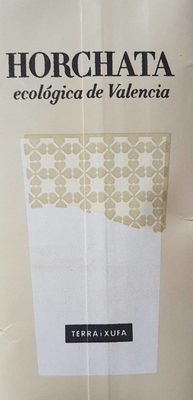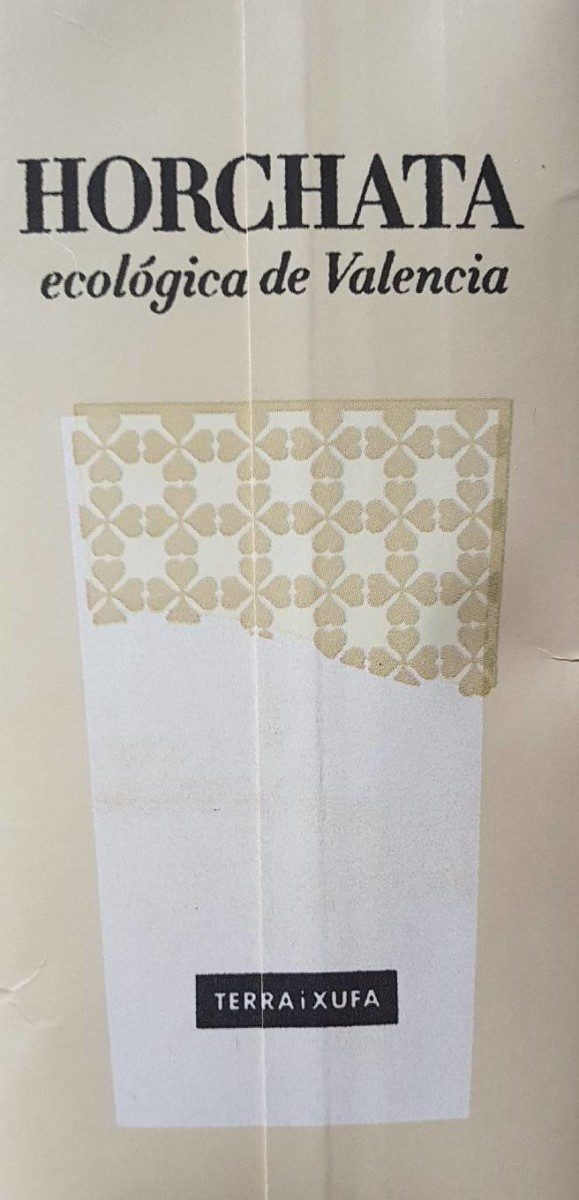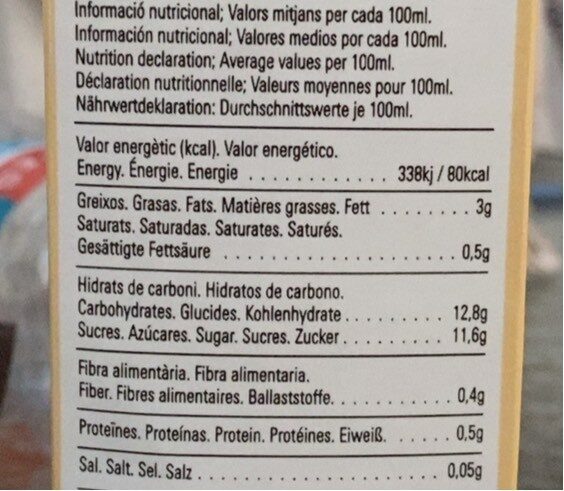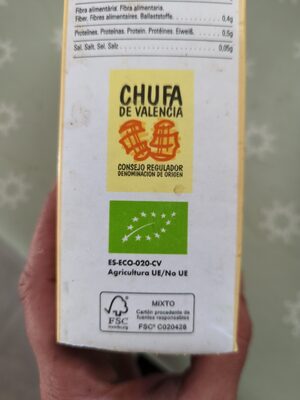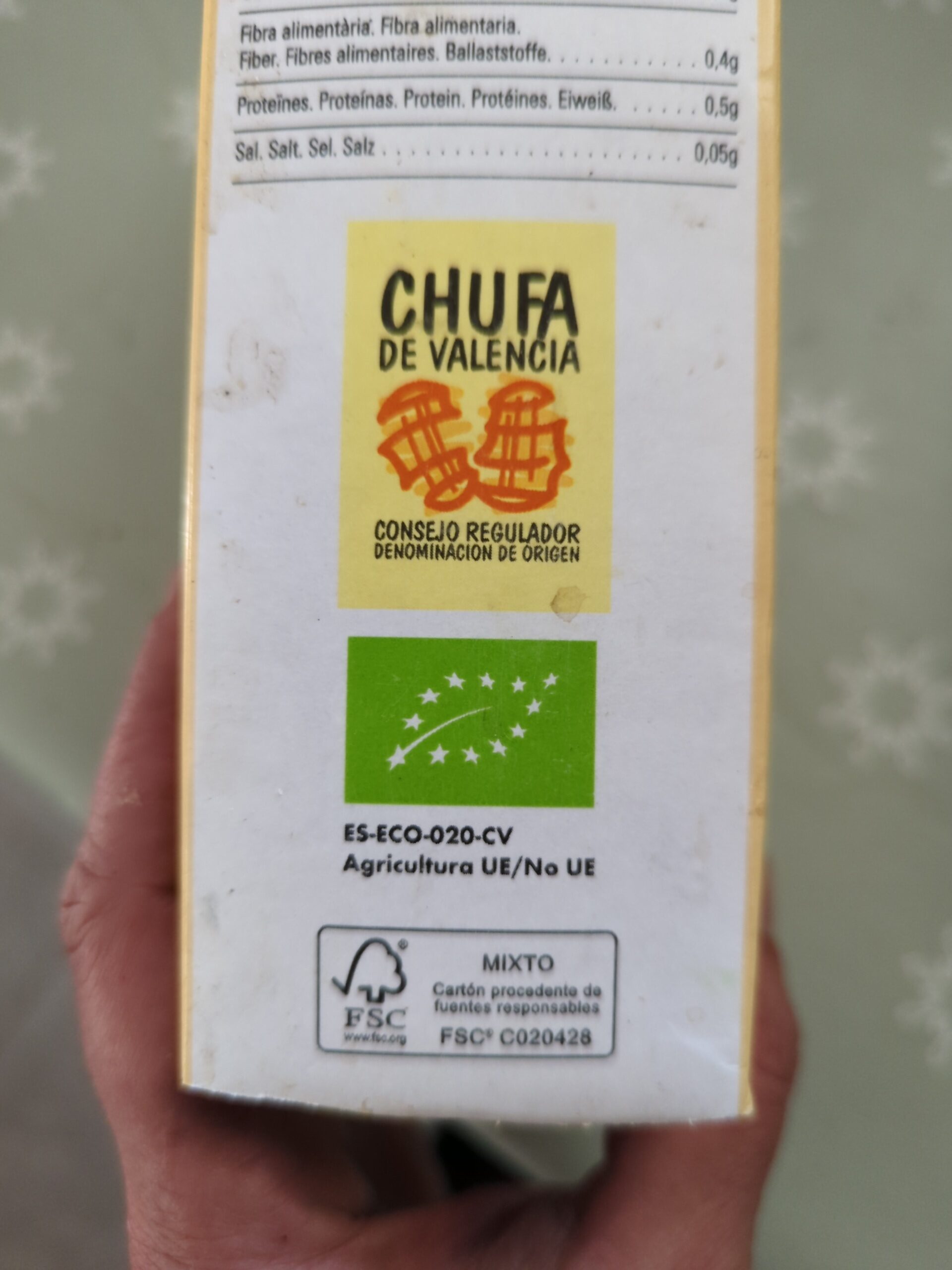Help us make food transparency the norm!
As a non-profit organization, we depend on your donations to continue informing consumers around the world about what they eat.
The food revolution starts with you!
Horchata ecológica de Valencia - Terra i Xufa - 1 l
Horchata ecológica de Valencia - Terra i Xufa - 1 l
Barra-kodea: 8410736050996 (EAN / EAN-13)
Izen arrunta: Horchata ecológica de Valencia
Kopurua: 1 l
Ontziratzea: fr:Tetrabrik
Markak: Terra i Xufa
Kategoriak: en:Plant-based foods and beverages, en:Beverages, en:Plant-based foods, en:Dairy substitutes, en:Milk substitutes, en:Nuts and their products, en:Plant-based beverages, en:Plant-based milk alternatives, en:Nut-based drinks, en:Tigernut-based drinks, en:Horchatas de chufa
Etiketak, ziurtagiriak, sariak:
en:Organic, en:EU Organic, en:Spanish protected product, ES-ECO-020-CV, en:FSC, en:FSC Mix, en:PDO, en:PDO Chufa de Valencia


Origin of the product and/or its ingredients: Chufa de Valencia
Origin of ingredients: Espainia, en:Valencia
Traceability code: FSC-C020428
Link to the product page on the official site of the producer: http://terraixufa.com/es/derivados-de-la...
Matching with your preferences
Health
Osagaiak
-
10 ingredients
Gaztelania: Agua, chufa* (Valencia) 15%, azúcar*, lecitina de girasol*, citratos de sodio, goma gellan, aromas naturales de limón y canela. (*) Procedentes de agricultura ecológica.Alergenoak: en:Nuts
Food processing
-
Ultra processed foods
Elements that indicate the product is in the 4 - Ultra prozesatutako elikagaiak eta edariak group:
- Gehigarria: E322
- Gehigarria: E418
- Osagaia: Flavouring
Food products are classified into 4 groups according to their degree of processing:
- Prozesatu gabeko edo ahalik eta gutxien prozesatutako elikagaiak
- Sukaldaritzako osagaiak prozesatu
- Prozesatutako jakiak
- Ultra processed foods
The determination of the group is based on the category of the product and on the ingredients it contains.
Gehigarriak
-
E322
Lecithin: Lecithin -UK: , US: , from the Greek lekithos, "egg yolk"- is a generic term to designate any group of yellow-brownish fatty substances occurring in animal and plant tissues, which are amphiphilic – they attract both water and fatty substances -and so are both hydrophilic and lipophilic-, and are used for smoothing food textures, dissolving powders -emulsifying-, homogenizing liquid mixtures, and repelling sticking materials.Lecithins are mixtures of glycerophospholipids including phosphatidylcholine, phosphatidylethanolamine, phosphatidylinositol, phosphatidylserine, and phosphatidic acid.Lecithin was first isolated in 1845 by the French chemist and pharmacist Theodore Gobley. In 1850, he named the phosphatidylcholine lécithine. Gobley originally isolated lecithin from egg yolk—λέκιθος lekithos is "egg yolk" in Ancient Greek—and established the complete chemical formula of phosphatidylcholine in 1874; in between, he had demonstrated the presence of lecithin in a variety of biological matters, including venous blood, in human lungs, bile, human brain tissue, fish eggs, fish roe, and chicken and sheep brain. Lecithin can easily be extracted chemically using solvents such as hexane, ethanol, acetone, petroleum ether, benzene, etc., or extraction can be done mechanically. It is usually available from sources such as soybeans, eggs, milk, marine sources, rapeseed, cottonseed, and sunflower. It has low solubility in water, but is an excellent emulsifier. In aqueous solution, its phospholipids can form either liposomes, bilayer sheets, micelles, or lamellar structures, depending on hydration and temperature. This results in a type of surfactant that usually is classified as amphipathic. Lecithin is sold as a food additive and dietary supplement. In cooking, it is sometimes used as an emulsifier and to prevent sticking, for example in nonstick cooking spray.Source: Wikipedia (Ingeles)
-
E322i - Lezitina
Lecithin: Lecithin -UK: , US: , from the Greek lekithos, "egg yolk"- is a generic term to designate any group of yellow-brownish fatty substances occurring in animal and plant tissues, which are amphiphilic – they attract both water and fatty substances -and so are both hydrophilic and lipophilic-, and are used for smoothing food textures, dissolving powders -emulsifying-, homogenizing liquid mixtures, and repelling sticking materials.Lecithins are mixtures of glycerophospholipids including phosphatidylcholine, phosphatidylethanolamine, phosphatidylinositol, phosphatidylserine, and phosphatidic acid.Lecithin was first isolated in 1845 by the French chemist and pharmacist Theodore Gobley. In 1850, he named the phosphatidylcholine lécithine. Gobley originally isolated lecithin from egg yolk—λέκιθος lekithos is "egg yolk" in Ancient Greek—and established the complete chemical formula of phosphatidylcholine in 1874; in between, he had demonstrated the presence of lecithin in a variety of biological matters, including venous blood, in human lungs, bile, human brain tissue, fish eggs, fish roe, and chicken and sheep brain. Lecithin can easily be extracted chemically using solvents such as hexane, ethanol, acetone, petroleum ether, benzene, etc., or extraction can be done mechanically. It is usually available from sources such as soybeans, eggs, milk, marine sources, rapeseed, cottonseed, and sunflower. It has low solubility in water, but is an excellent emulsifier. In aqueous solution, its phospholipids can form either liposomes, bilayer sheets, micelles, or lamellar structures, depending on hydration and temperature. This results in a type of surfactant that usually is classified as amphipathic. Lecithin is sold as a food additive and dietary supplement. In cooking, it is sometimes used as an emulsifier and to prevent sticking, for example in nonstick cooking spray.Source: Wikipedia (Ingeles)
-
E331
Sodium citrate: Sodium citrate may refer to any of the sodium salts of citrate -though most commonly the third-: Monosodium citrate Disodium citrate Trisodium citrateThe three forms of the salt are collectively known by the E number E331. Sodium citrates are used as acidity regulators in food and drinks, and also as emulsifiers for oils. They enable cheeses to melt without becoming greasy.Source: Wikipedia (Ingeles)
-
E418
Gellan gum: Gellan gum is a water-soluble anionic polysaccharide produced by the bacterium Sphingomonas elodea -formerly Pseudomonas elodea based on the taxonomic classification at the time of its discovery-. Its taxonomic classification has been subsequently changed to Sphingomonas elodea based on current classification system. The gellan-producing bacterium was discovered and isolated by the former Kelco Division of Merck & Company, Inc. in 1978 from the lily plant tissue from a natural pond in Pennsylvania, USA. It was initially identified as a substitute gelling agent at significantly lower use level to replace agar in solid culture media for the growth of various microorganisms Its initial commercial product with the trademark as "GELRITE" gellan gum, was subsequently identified as a suitable agar substitute as gelling agent in various clinical bacteriological media.Source: Wikipedia (Ingeles)
Ingredients analysis
-
en:Palm oil free
No ingredients containing palm oil detected
Unrecognized ingredients: es:valencia, es:procedentesSome ingredients could not be recognized.
We need your help!
You can help us recognize more ingredients and better analyze the list of ingredients for this product and others:
- Edit this product page to correct spelling mistakes in the ingredients list, and/or to remove ingredients in other languages and sentences that are not related to the ingredients.
- Add new entries, synonyms or translations to our multilingual lists of ingredients, ingredient processing methods, and labels.
If you would like to help, join the #ingredients channel on our Slack discussion space and/or learn about ingredients analysis on our wiki. Thank you!
-
en:Vegan status unknown
Unrecognized ingredients: es:valencia, es:procedentesSome ingredients could not be recognized.
We need your help!
You can help us recognize more ingredients and better analyze the list of ingredients for this product and others:
- Edit this product page to correct spelling mistakes in the ingredients list, and/or to remove ingredients in other languages and sentences that are not related to the ingredients.
- Add new entries, synonyms or translations to our multilingual lists of ingredients, ingredient processing methods, and labels.
If you would like to help, join the #ingredients channel on our Slack discussion space and/or learn about ingredients analysis on our wiki. Thank you!
-
en:Vegetarian status unknown
Unrecognized ingredients: es:valencia, es:procedentesSome ingredients could not be recognized.
We need your help!
You can help us recognize more ingredients and better analyze the list of ingredients for this product and others:
- Edit this product page to correct spelling mistakes in the ingredients list, and/or to remove ingredients in other languages and sentences that are not related to the ingredients.
- Add new entries, synonyms or translations to our multilingual lists of ingredients, ingredient processing methods, and labels.
If you would like to help, join the #ingredients channel on our Slack discussion space and/or learn about ingredients analysis on our wiki. Thank you!
-
Details of the analysis of the ingredients
We need your help!
Some ingredients could not be recognized.
We need your help!
You can help us recognize more ingredients and better analyze the list of ingredients for this product and others:
- Edit this product page to correct spelling mistakes in the ingredients list, and/or to remove ingredients in other languages and sentences that are not related to the ingredients.
- Add new entries, synonyms or translations to our multilingual lists of ingredients, ingredient processing methods, and labels.
If you would like to help, join the #ingredients channel on our Slack discussion space and/or learn about ingredients analysis on our wiki. Thank you!
es: Agua, chufa 15% (Valencia), azúcar, lecitina de girasol, citratos de sodio, goma gellan, aromas naturales de limón, canela (), Procedentes- Agua -> en:water - vegan: yes - vegetarian: yes - ciqual_food_code: 18066 - percent_min: 33.59999847412 - percent_max: 85
- chufa -> en:tigernut - vegan: yes - vegetarian: yes - percent_min: 15 - percent: 15 - percent_max: 15
- Valencia -> es:valencia - percent_min: 15 - percent_max: 15
- azúcar -> en:sugar - vegan: yes - vegetarian: yes - ciqual_proxy_food_code: 31016 - percent_min: 0 - percent_max: 11.60000038147
- lecitina de girasol -> en:sunflower-lecithin - vegan: yes - vegetarian: yes - percent_min: 0 - percent_max: 11.60000038147
- citratos de sodio -> en:e331 - vegan: yes - vegetarian: yes - percent_min: 0 - percent_max: 11.60000038147
- goma gellan -> en:e418 - vegan: yes - vegetarian: yes - percent_min: 0 - percent_max: 11.60000038147
- aromas naturales de limón -> en:natural-lemon-flavouring - vegan: yes - vegetarian: yes - percent_min: 0 - percent_max: 5
- canela -> en:cinnamon - vegan: yes - vegetarian: yes - percent_min: 0 - percent_max: 0
- Procedentes -> es:procedentes - labels: en:organic - percent_min: 0 - percent_max: 0
Elikadura
-
Good nutritional quality
⚠ ️Abisua: zuntz kopurua ez dago zehaztuta, ezin izan dute kontuan izan kalifikaziorako izan dezaketen ekarpen positiboa.⚠ ️Warning: the amount of fruits, vegetables and nuts is not specified on the label, it was estimated from the list of ingredients: 15This product is not considered a beverage for the calculation of the Nutri-Score.
Positive points: 0
- Proteinak: 0 / 5 (balioa: 0.5, rounded value: 0.5)
- Fiber: 0 / 5 (balioa: 0, rounded value: 0)
- Fruits, vegetables, nuts, and colza/walnut/olive oils: 0 / 5 (balioa: 15, rounded value: 15)
Negative points: 2
- Energia: 0 / 10 (balioa: 335, rounded value: 335)
- Azukreak: 2 / 10 (balioa: 11.60000038147, rounded value: 11.6)
- Gantz saturatua: 0 / 10 (balioa: 0.5, rounded value: 0.5)
- Sodioa: 0 / 10 (balioa: 20.0000002980232, rounded value: 20)
The points for proteins are counted because the negative points are less than 11.
Nutritional score: (2 - 0)
Nutri-Score:
-
Nutrient levels
-
Koipe in moderate quantity (3%)
What you need to know- A high consumption of fat, especially saturated fats, can raise cholesterol, which increases the risk of heart diseases.
Recommendation: Limit the consumption of fat and saturated fat- Choose products with lower fat and saturated fat content.
-
Gantz-azido ase in low quantity (0.5%)
What you need to know- A high consumption of fat, especially saturated fats, can raise cholesterol, which increases the risk of heart diseases.
Recommendation: Limit the consumption of fat and saturated fat- Choose products with lower fat and saturated fat content.
-
Azukre in high quantity (11.6%)
What you need to know- A high consumption of sugar can cause weight gain and tooth decay. It also augments the risk of type 2 diabetes and cardio-vascular diseases.
Recommendation: Limit the consumption of sugar and sugary drinks- Sugary drinks (such as sodas, fruit beverages, and fruit juices and nectars) should be limited as much as possible (no more than 1 glass a day).
- Choose products with lower sugar content and reduce the consumption of products with added sugars.
-
Gatz arrunt in low quantity (0.05%)
What you need to know- A high consumption of salt (or sodium) can cause raised blood pressure, which can increase the risk of heart disease and stroke.
- Many people who have high blood pressure do not know it, as there are often no symptoms.
- Most people consume too much salt (on average 9 to 12 grams per day), around twice the recommended maximum level of intake.
Recommendation: Limit the consumption of salt and salted food- Reduce the quantity of salt used when cooking, and don't salt again at the table.
- Limit the consumption of salty snacks and choose products with lower salt content.
-
-
Nutrition facts
Nutrition facts Compared to: en:Horchatas de chufa Energia -% 1 Koipe +% 11 Gantz-azido ase -% 18 Carbohydrates -% 6 Azukre +% 5 Fiber Proteina -% 26 Gatz arrunt -% 40 Fruits‚ vegetables‚ nuts and rapeseed‚ walnut and olive oils (estimate from ingredients list analysis)
Ingurumena
-
Eco-Score A - Very low environmental impact
The Eco-Score is an experimental score that summarizes the environmental impacts of food products.→ The Eco-Score was initially developped for France and it is being extended to other European countries. The Eco-Score formula is subject to change as it is regularly improved to make it more precise and better suited to each country.Life cycle analysis
-
Average impact of products of the same category: B (Score: 79/100)
Kategoria: Almond drink not sweet, not fortified, prepacked
Kategoria: Almond drink not sweet, not fortified, prepacked
- PEF environmental score: 0.06 (the lower the score, the lower the impact)
- including impact on climate change: 0.37 kg CO2 eq/kg of product
Stage Impact Agriculture
37.0 %Processing
24.3 %Ontziratzea
16.2 %Transportation
15.6 %Distribution
6.9 %Consumption
0.0 %
Bonuses and maluses
-
Labels with high environmental benefits
Bonus: +15
-
EU Organic
Organic agriculture contributes to preserve biodiversity, climate, water quality and soil fertility.
Organic food is food produced by methods complying with the standards of organic farming and features practices that cycle resources, promote ecological balance, and conserve biodiversity.
-
-
Origins of ingredients with a low impact
Bonus: +18
Environmental policy: +3
Transportation: +15
Origin of the product and/or its ingredients % of ingredients Impact Espainia 100 %Baxua
-
Packaging with a low impact
Malus: -4
Shape Material Recycling Impact 1 Brick Tetra Pak ecoponto-amarelo Medium
Eco-Score for this product
-
Impact for this product: A (Score: 104/100)
Produktua: Horchata ecológica de Valencia - Terra i Xufa - 1 l
Life cycle analysis score: 79
Sum of bonuses and maluses: +25 ()
Final score: 104/100
-
Carbon footprint
-
Equal to driving 0.2 km in a petrol car
37 g CO² per 100g of product
The carbon emission figure comes from ADEME's Agribalyse database, for the category: Almond drink not sweet, not fortified, prepacked (Source: ADEME Agribalyse Database)
Stage Impact Agriculture
19.2 %Processing
18.5 %Ontziratzea
26.9 %Transportation
31.6 %Distribution
3.9 %Consumption
0.0 %
Ontziratzea
-
Packaging with a low impact
-
Packaging parts
1 x Brick 1l (Tetra Pak)
-
Bilgarriaren materialak
Material % Bilgarriaren pisua Bilgarriaren pisua produktuaren 100g-ko
-
Transportation
-
Origins of ingredients
Origins of ingredients with a low impact
Origin of the product and/or its ingredients % of ingredients Impact Espainia 100 %Baxua
Etiketak
-
EU Organic
Organic agriculture contributes to preserve biodiversity, climate, water quality and soil fertility.
Organic food is food produced by methods complying with the standards of organic farming and features practices that cycle resources, promote ecological balance, and conserve biodiversity.
Report a problem
-
Incomplete or incorrect information?
Category, labels, ingredients, allergens, nutritional information, photos etc.
If the information does not match the information on the packaging, please complete or correct it. Open Food Facts is a collaborative database, and every contribution is useful for all.
Datuen iturria
Product added on by kiliweb
Last edit of product page on by 5m4u9.
Produktuaren orria -gatik editatua mariacastiel, neptuno, openfoodfacts-contributors, roboto-app, teolemon, yuka.DLJ7MdXRG94jG_H_6I8RgWW5Mcb_OKVQJWEfoQ, yuka.DYJvFeK6EMUcGvXr87gO-hGKHrn_LdNlRyIWoQ, yuka.L5QeZoelRuoCPcjWi4IWxCWiScnmB99UNWEfoQ, yuka.VkxJdUlJNWJwdmtCdmNRbjh5UDZ4Zk5Od29hQURVRzVFK00ySVE9PQ.
